Science & Environment
Generator maker Generac soars, insurance stocks fall on Hurricane Milton
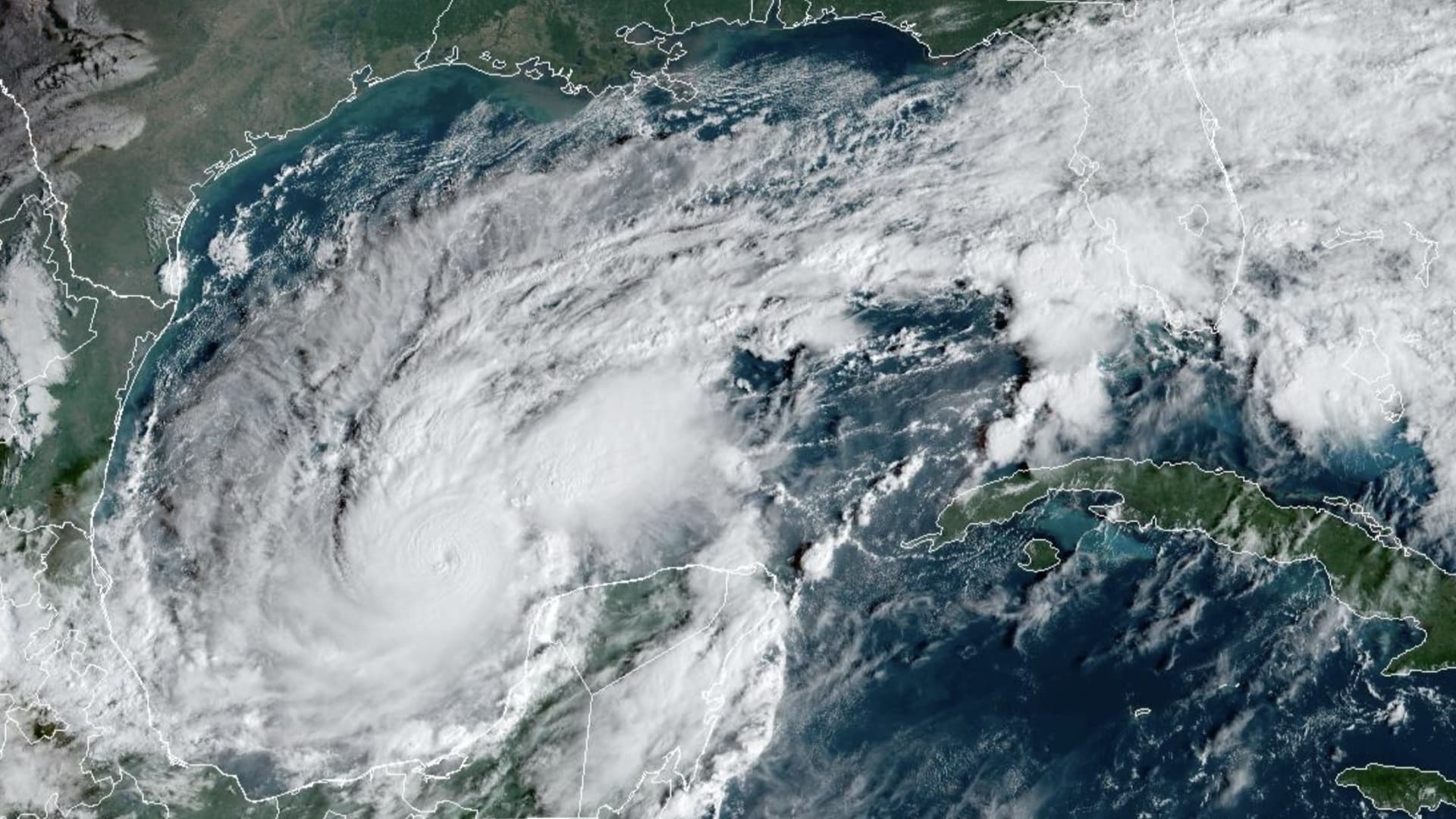
A worker unloads a 24-kilowatt Generac home generator off a truck at Captain Electric on February 18, 2021 in Orem, Utah.
George Frey | Getty Images
Shares of backup power generation company Generac Holdings surged more than 7% on Monday as Hurricane Milton rapidly strengthened into a Category 4 storm.
Milton is forecast to move north of the Yucatan Peninsula Monday and Tuesday before crossing the Gulf of Mexico to approach Florida by Wednesday, according to the National Hurricane Center. Tampa Bay could face a storm surge of eight to 12 feet, according to forecasters.
Insurance stocks that have weather catastrophe exposure, meanwhile, are falling on potential insured losses tied to Hurricane Milton. Allstate, Travelers and Chubb saw their shares fall more than 3%, while Progressive and AIG all declined more than 1%.
Universal Insurance, based in Fort. Lauderdale, plunged more than 20% as the catastrophe-prone carrier with Gulf Coast exposure could see heightened hurricane risks.
This is a developing story. Please check back for updates.
Science & Environment
Daniele Oriti: The physicist who argues that there are no objective laws of physics
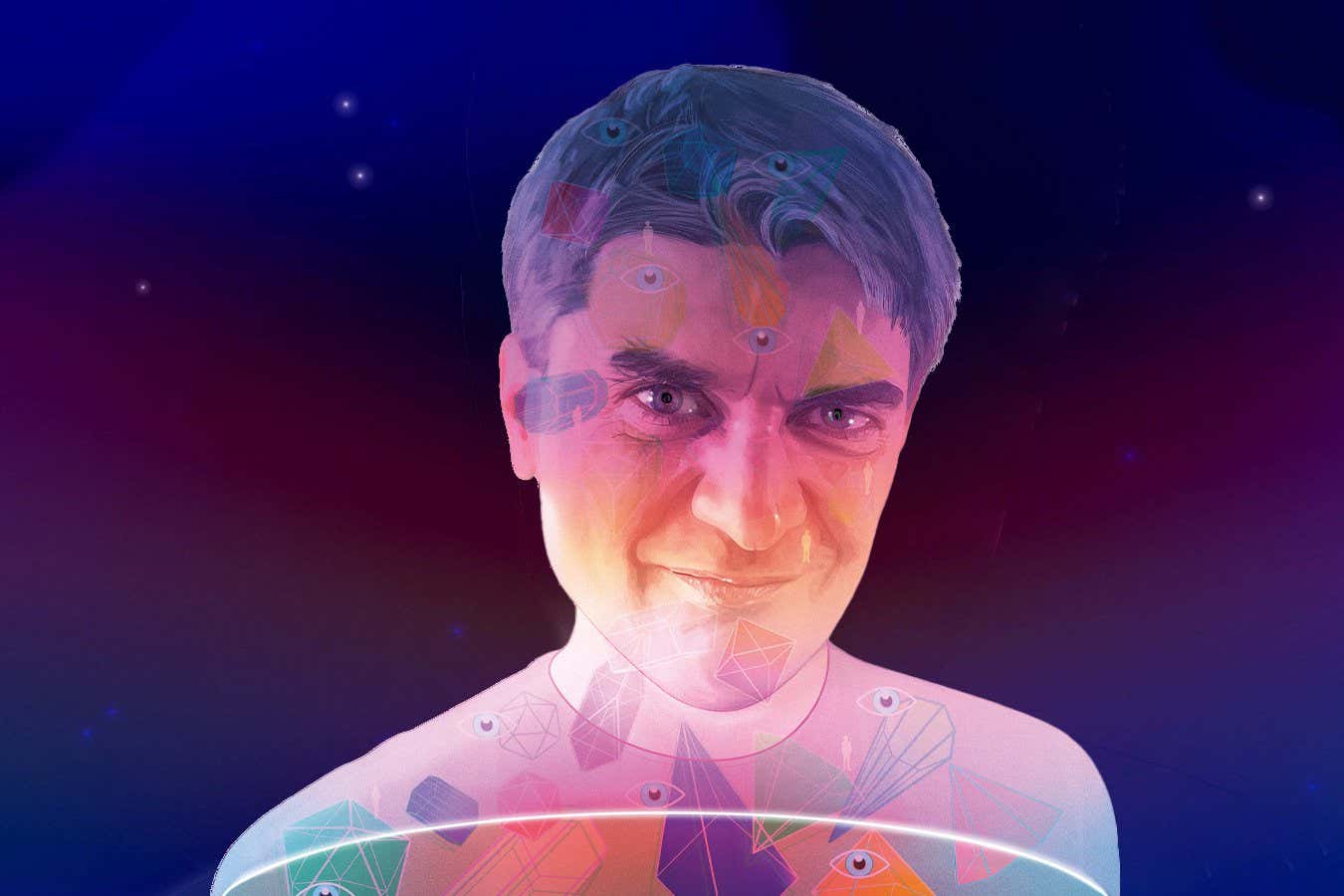

Most physicists operate under the assumption that there is a world out there that is entirely independent of us, an objective reality in which more-or-less well-defined things behave according to immutable physical laws. Yet over the past century, ever since the development of quantum theory, there have been discombobulating questions about the role of observers – not least ourselves – in the makings of reality.
These questions are often brushed under the carpet, but Daniele Oriti, a theorist at the Complutense University of Madrid, prefers to confront them. Arguably, he has been pushed to do so by his work on one of the foremost challenges in modern physics: creating a quantum theory of gravity. The difficulty here is reconciling the inherently smooth picture of space-time in general relativity with quantum theory, which is written in contradictory mathematical language. Getting the two to play nicely together has forced Oriti to think deeply about the subtleties of physical laws – not least the fact that space-time is a shaky foundation on which to build them. His verdict? That physical laws can’t exist independently of us, as something that we can all agree on, but instead reside within us somehow.
Oriti spoke to New Scientist about how he came to such a startling conclusion, why physicists need to be more aware of the complex relations between the world, scientific models and observers, and how appreciating the true nature of physical laws might yield fresh breakthroughs.
Thomas Lewton: What do people get wrong about the nature of reality?
Daniele Oriti: At the risk of…
Science & Environment
SpaceX launches European asteroid probe as hurricane weather closes in
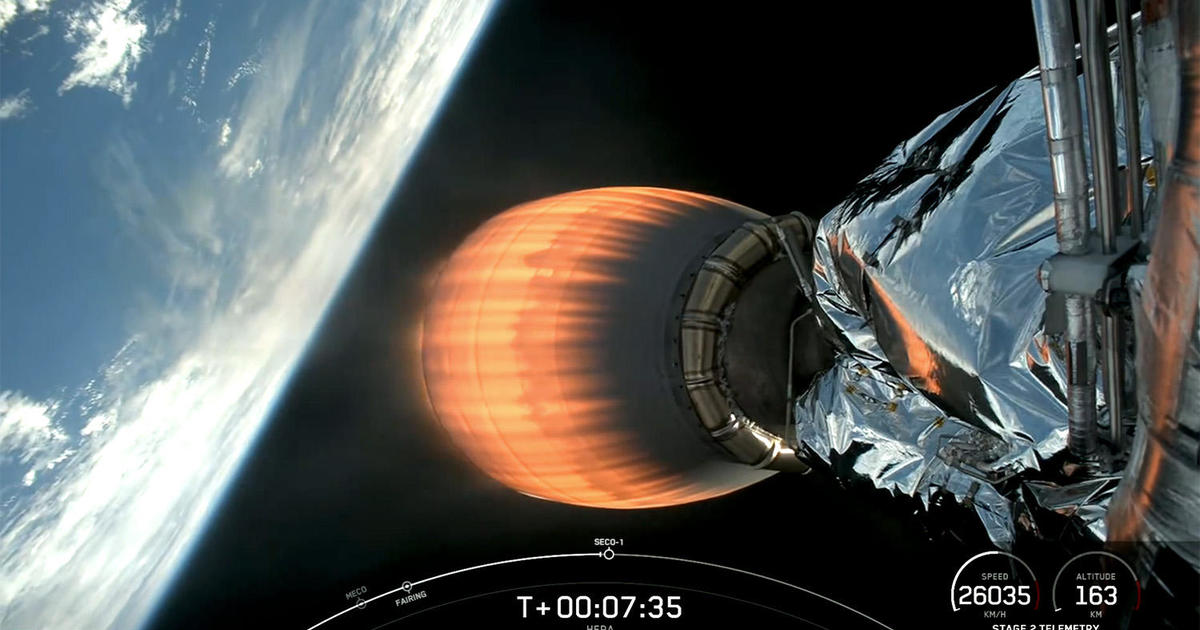
Dodging stormy weather ahead of Hurricane Milton, SpaceX launched the European Space Agency’s $398 million Hera probe Monday on a follow-up flight to find out precisely how a moonlet orbiting a small asteroid was affected by the high-speed impact of NASA’s DART probe in 2022.
The launching was in doubt until the last moment, with thick clouds and rain across Florida’s Space Coast, fueled by moisture pulled in by the intensifying hurricane to the west.
But as the launch time approached, conditions improved enough to satisfy launch safety rules and NASA managers cleared the rocket for takeoff. Right on time, at 10:52 a.m. EDT, the Falcon 9’s first stage engines ignited with a burst of flame and the booster climbed smoothly away from the Cape Canaveral Space Force Station.
Liftoff came in the nick of time for several hundred European Space Agency managers, scientists, engineers and journalists who flew to Florida to watch the launch.
Hurricane Milton is expected to bring extreme winds and torrential rain to Florida’s Space Coast by Wednesday, a forecast that prompted NASA to stand down on plans to launch the agency’s $5.2 billion Europa mission to Jupiter and its ice-covered moon Europa on Thursday.
Instead, NASA announced late Sunday the rocket and it costly payload will remain in a SpaceX hangar at the base of launch pad 39A at the Kennedy Space Center until Milton passes by and safety personnel have a chance to inspect spaceport facilities for signs of damage.
The weather also has thrown a wrench into NASA’s plans to bring three NASA astronauts and a Russian cosmonaut back to Earth after a 217-day stay aboard the International Space Station.
Crew 8 commander Matthew Dominick, Mike Barratt, Jeanette Epps and cosmonaut Alexander Grebenkin had planned to undock Monday.
But NASA announced Sunday their departure would be delayed to at least Thursday because of the expected bad weather. Crew Dragon ferry ships require calm winds and seas in the Gulf of Mexico or the Atlantic Ocean to permit a safe splashdown.
Mission to an asteroid and its moon
In the meantime, despite an initially grim forecast, SpaceX was able to take advantage of a break in the weather to kick off Hera’s two-year voyage to the asteroid Didymos and its small moon Dimorphos.
The DART impact altered the 11-hour 55-minute orbit of the 495-foot-wide Dimorphos, shaving 31 minutes off the time needed to complete one trip around the parent asteroid Didymos. The test confirmed the feasibility of someday nudging a threatening asteroid off course before a possibly devastating Earth impact.
But a successful deflection would depend on a variety of factors, including when the threat was detected — the farther out, the better — and the asteroid’s composition.
ESA’s Hera probe will orbit the Didymos system and study both asteroids in detail with 11 high-tech cameras and other instruments, deploying two small “cubesat” satellites to study the interior structure of Dimorphos, assess the DART impact crater, the moon’s internal structure and composition.
The goal of the Asteroid Impact and Deflection Assessment, or AIDA, is to better understand the techniques that might be needed to prevent an Earth impact.
“The good news is no dinosaur killer is on its way to Earth during the next 100 years,” said
Richard Moissl, director of ESA’s Planetary Defense Office. “We are safe from that scenario, but there are smaller ones, especially in this dangerous size, 50 meters and upwards, where it really threatens human life on the ground.”
The first step in planetary defense is detection, he said, followed by detailed observations to pin down the asteroid’s orbit and determine whether a collision with Earth is a possibility.
“For small objects, civil protection is the way to go,” he said. “But 50 meters (160 feet across) and larger, you really want this thing not to hit Earth, not to threaten population centers. And then step three comes into play, deflection.
“But again, it’s always good to know what you’re up against. And this is where Hera and DART come into play.”
Unlike most Falcon 9 flights, there were no plans to recover the rocket’s first stage. To give Hera the velocity need to break free of Earth gravity, the Falcon 9’s two stages were programmed to use up all of their propellants, leaving none in reserve for a powered first stage landing.
The flight plan called for two firings of the upper stage engine before Hera’s release to fly on its own one hour and 16 minutes after liftoff.
To reach Didymos and Dimorphos, Hera will have to execute a deep space thruster firing in November to set up a gravity-assist flyby of Mars in March, sailing within about 3,700 miles of the red planet. Along the way, the spacecraft will pass within 620 miles of the small martian moon Deimos.
“By swinging through the gravitational field of Mars in its direction of movement, the spacecraft gains added velocity for its onward journey,” Michael Kueppers, ESA’s project scientist, said on the agency’s website.
“This close encounter is not part of Hera’s core mission, but we will have several of our science instruments activated anyway. It gives us another chance to calibrate our instruments and potentially to make some scientific discoveries.”
After another deep space maneuver in February 2026, Hera will finally be on course to slip into orbit around Didymos the following October. The mission is expected to last about six months.
Science & Environment
Hera spacecraft to visit Dimorphos asteroid that humans knocked off course
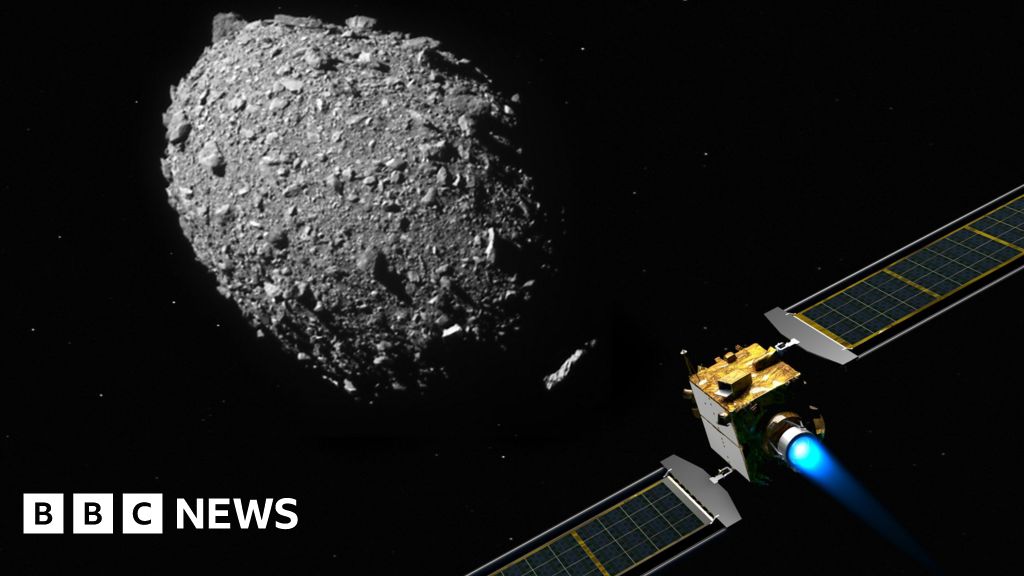
A spacecraft is due to launch from Florida destined for an asteroid that US space agency Nasa knocked off course in 2022.
It is part of an international mission to see if we can stop dangerous asteroids hitting Earth.
The Hera craft will look at what happened to a space rock called Dimorphos when Nasa intentionally collided with it.
If all goes to plan, the spacecraft will reach Dimorphos in December 2026.
The Hera mission, which is run by the European Space Agency, is a follow-on from Nasa’s Double Asteroid Redirection Test (DART) project.
Dimorphos is a small moon 160m-wide that orbits an asteroid close to Earth called Didymos in something called a binary asteroid system.
In 2022 Nasa said it successfully changed Dimorphos’s course by crashing a probe into it. It altered the rock’s path by a few metres, according to Nasa’s scientists.
The asteroid was not on course to hit Earth, but it was a test to see whether space agencies could do it when there is genuine risk.
Now the Hera craft will look at the size and depth of the impact crater created on Dimorphos.
Two cube-shaped probes will also study the make-up of the asteroid and its mass.
“We need to understand what are the physical properties of these asteroids? What are they made of? Are they blocks of rock? Are they made of sand inside?” says Naomi Murdoch, a scientist involved with the European Space Agency mission.
That should help scientists understand the best way to attempt to intercept other asteroids, which can be many different sizes and shapes, in the future.
Scientists do not believe that we are currently at risk of a dinosaur-style extinction caused by an asteroid hitting Earth. An asteroid of that size could be easily spotted in space.
The size of asteroid that DART and Hera are targeting are about 100-200m wide and are very difficult to see from our planet.
From time to time they hit Earth. On 2013 a house-sized asteroid exploded in the sky above the town of Chelyabinsk in Russia. The shock wave blew out windows for over 200 square miles and damaged buildings. Over 1,600 people were injured in the blast.
Scientists hope to one day be able to identify asteroids like this and knock them off course.
“It’s not to avoid an extinction of the human race. It’s to create a system to minimize the damage as much as we can. The dinosaurs didn’t have a space program, but we do,” says Prof Murdoch.
But scientists warn that even though Nasa has proved it is possible to alter one asteroid’s course, it does not mean it can easily be done on all space rocks.
Intercepting an asteroid before it hits Earth also relies on being able to spot the incoming hazard in the first place.
Science & Environment
Nobel Prize goes to microRNA researchers
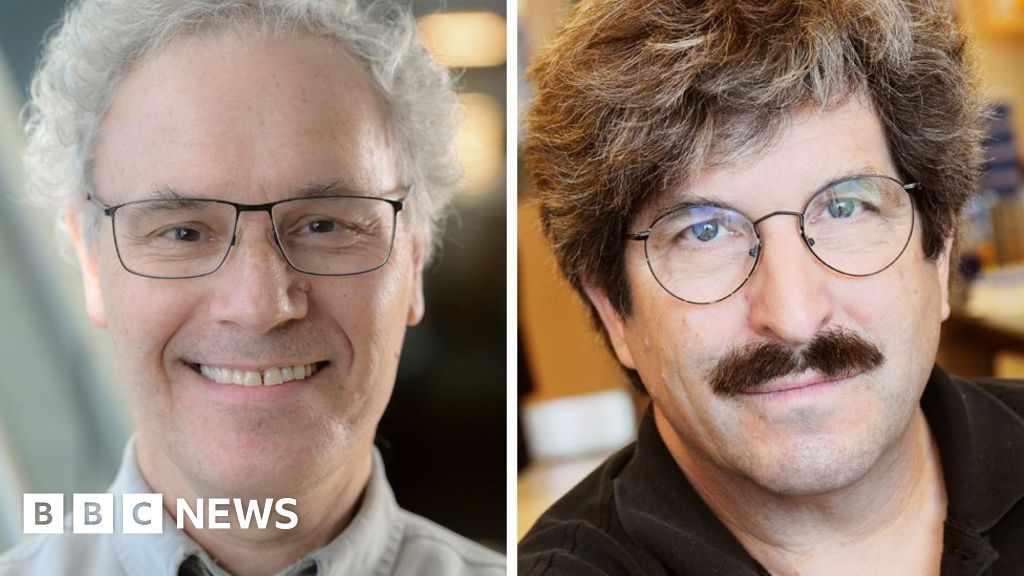
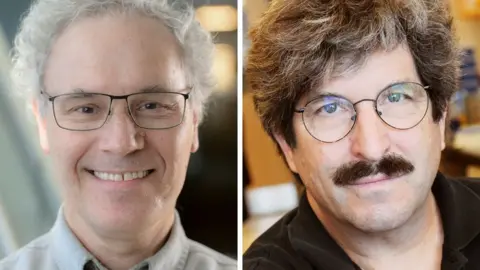 Reuters
ReutersThe Nobel Prize in Physiology or Medicine 2024 has been awarded to US scientists Victor Ambros and Gary Ruvkun for their work on microRNA.
Their discoveries help explain how complex life emerged on Earth and how the human body is made up of a wide variety of different tissues.
MicroRNAs influence how genes – the instructions for life – are controlled inside organisms, including us.
The winners share a prize fund worth 11m Swedish kronor (£810,000).
Every cell in the human body contains the same raw genetic information, locked in our DNA.
However, despite starting with the identical genetic information, the cells of the human body are wildly different in form and function.
The electrical impulses of nerve cells are distinct from the rhythmic beating of heart cells. The metabolic powerhouse that is a liver cell is distinct to a kidney cell, which filters urea out of the blood. The light-sensing abilities of cells in the retina are different in skillset to white blood cells that produce antibodies to fight infection.
So much variety can arise from the same starting material because of gene expression.
The US scientists were the first to discover microRNAs and how they exerted control on how genes are expressed differently in different tissues.
The medicine and physiology prize winners are selected by the Nobel Assembly of Sweden’s Karolinska Institute.
They said: “Their groundbreaking discovery revealed a completely new principle of gene regulation that turned out to be essential for multicellular organisms, including humans.
“It is now known that the human genome codes for over 1,000 microRNAs.”
Allow Twitter content?
Without the ability to control gene expression, every cell in an organism would be identical, so microRNAs helped enable the evolution of complex life forms.
Abnormal regulation by microRNAs can contribute to cancer and to some conditions, including congenital hearing loss and bone disorders.
A severe example is DICER1 syndrome, which leads to cancer in a variety of tissues, and is caused by mutations that affect microRNAs.
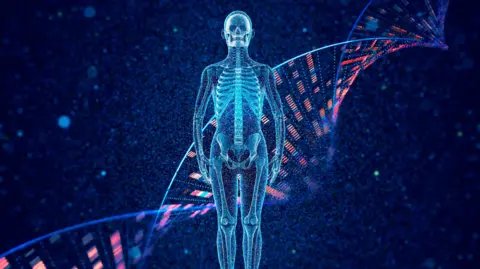 Getty Images
Getty ImagesProf Ambros, 70, works at the University of Massachusetts Medical School, and Prof Ruvkun, 72, is a professor at Harvard Medical School.
Both conducted their research on the nematode worm – C. elegans.
They experimented on a mutant form of the worm that failed to develop some cell types, and eventually homed in on tiny pieces of genetic material or microRNAs that were essential for the worms’ development.
This is how it works:
- A gene or genetic instruction is contained within our DNA
- Our cells make a copy, which is called messenger RNA or simply mRNA (you’ll remember this from Covid vaccines)
- This travels out of the cell’s nucleus and instructs the cell’s protein-making factories to start making a specific protein
- But microRNAs get in the way by sticking to the messenger RNA and stop it working
- In essence the mircoRNA has prevented the gene from being expressed in the cell
Further work showed this was not a process unique to worms, but was a core component of life on Earth.
Prof Janosch Heller, from Dublin City University, said he was “delighted” to hear the prize had gone to Profs Ambros and Ruvkun.
“Their pioneering work into gene regulation by microRNAs paved the way for groundbreaking research into novel therapies for devastating diseases such as epilepsy, but also opened our eyes to the wonderful machinery that is tightly controlling what is happening in our cells.”
Previous winners
Science & Environment
Oil jumps as market waits for Israel attack on Iran


U.S. crude oil rose nearly 3% on Monday, as the market waited for Israel to strike Iran.
Oil prices spiked last week on fears that Israel could hit the Iran’s oil industry in retaliation for Tehran’s ballistic missile attack.
U.S benchmark West Texas Intermediate surged 9.09% last week for the biggest weekly gain since March 2023. Global benchmark Brent jumped 8.43% for the biggest weekly advance since January 2023.
Here are Monday’s energy prices:
- West Texas Intermediate November contract: $76.44 per barrel, up $2.06, or 2.77%.
- Brent December contract: $79.91 per barrel, $1.86, or 2.38%.
President Joe Biden on Friday discouraged Israel from striking Iranian oil facilities, after prices jumped about 5% a day earlier when the president suggested the U.S. was discussing the possibility of such a strike.
Science & Environment
Fed rate cuts should favor preferred stocks, Virtus fund manager says


One financial firm is trying to capitalize on preferred stocks – which carry more risks than bonds, but aren’t as risky as common stocks.
Infrastructure Capital Advisors Founder and CEO Jay Hatfield manages the Virtus InfraCap U.S. Preferred Stock ETF (PFFA). He leads the company’s investing and business development.
“High yield bonds and preferred stocks… tend to do better than other fixed income categories when the stock market is strong, and when we’re coming out of a tightening cycle like we are now,” he told CNBC’s “ETF Edge” this week.
Hatfield’s ETF is up 10% in 2024 and almost 23% over the past year.
His ETF’s three top holdings are Regions Financial, SLM Corporation, and Energy Transfer LP as of Sept. 30, according to FactSet. All three stocks are up about 18% or more this year.
Hatfield’s team selects names that it deems are mispriced relative to their risk and yield, he said. “Most of the top holdings are in what we call asset intensive businesses,” Hatfield said.
Since its May 2018 inception, the Virtus InfraCap U.S. Preferred Stock ETF is down almost 9%.
-

 Womens Workouts2 weeks ago
Womens Workouts2 weeks ago3 Day Full Body Women’s Dumbbell Only Workout
-

 Science & Environment3 weeks ago
Science & Environment3 weeks agoHow to unsnarl a tangle of threads, according to physics
-

 Science & Environment3 weeks ago
Science & Environment3 weeks agoHyperelastic gel is one of the stretchiest materials known to science
-

 Science & Environment3 weeks ago
Science & Environment3 weeks agoMaxwell’s demon charges quantum batteries inside of a quantum computer
-

 Technology3 weeks ago
Technology3 weeks agoWould-be reality TV contestants ‘not looking real’
-

 Science & Environment3 weeks ago
Science & Environment3 weeks ago‘Running of the bulls’ festival crowds move like charged particles
-

 Science & Environment3 weeks ago
Science & Environment3 weeks agoHow to wrap your mind around the real multiverse
-

 News2 weeks ago
News2 weeks agoOur millionaire neighbour blocks us from using public footpath & screams at us in street.. it’s like living in a WARZONE – WordupNews
-

 Science & Environment3 weeks ago
Science & Environment3 weeks agoSunlight-trapping device can generate temperatures over 1000°C
-

 Science & Environment3 weeks ago
Science & Environment3 weeks agoQuantum ‘supersolid’ matter stirred using magnets
-

 Science & Environment3 weeks ago
Science & Environment3 weeks agoITER: Is the world’s biggest fusion experiment dead after new delay to 2035?
-

 Science & Environment3 weeks ago
Science & Environment3 weeks agoLiquid crystals could improve quantum communication devices
-

 Science & Environment3 weeks ago
Science & Environment3 weeks agoQuantum forces used to automatically assemble tiny device
-
News3 weeks ago
the pick of new debut fiction
-

 Science & Environment3 weeks ago
Science & Environment3 weeks agoPhysicists are grappling with their own reproducibility crisis
-

 Science & Environment3 weeks ago
Science & Environment3 weeks agoWhy this is a golden age for life to thrive across the universe
-

 News3 weeks ago
News3 weeks agoYou’re a Hypocrite, And So Am I
-

 Sport3 weeks ago
Sport3 weeks agoJoshua vs Dubois: Chris Eubank Jr says ‘AJ’ could beat Tyson Fury and any other heavyweight in the world
-

 Science & Environment3 weeks ago
Science & Environment3 weeks agoTime travel sci-fi novel is a rip-roaringly good thought experiment
-

 Science & Environment3 weeks ago
Science & Environment3 weeks agoLaser helps turn an electron into a coil of mass and charge
-

 Science & Environment3 weeks ago
Science & Environment3 weeks agoCaroline Ellison aims to duck prison sentence for role in FTX collapse
-

 Science & Environment3 weeks ago
Science & Environment3 weeks agoNuclear fusion experiment overcomes two key operating hurdles
-

 Technology1 week ago
Technology1 week ago‘From a toaster to a server’: UK startup promises 5x ‘speed up without changing a line of code’ as it plans to take on Nvidia, AMD in the generative AI battlefield
-

 Football1 week ago
Football1 week agoFootball Focus: Martin Keown on Liverpool’s Alisson Becker
-
Business1 week ago
Eurosceptic Andrej Babiš eyes return to power in Czech Republic
-

 Science & Environment3 weeks ago
Science & Environment3 weeks agoRethinking space and time could let us do away with dark matter
-

 MMA1 week ago
MMA1 week agoConor McGregor challenges ‘woeful’ Belal Muhammad, tells Ilia Topuria it’s ‘on sight’
-

 Science & Environment3 weeks ago
Science & Environment3 weeks agoNerve fibres in the brain could generate quantum entanglement
-

 News3 weeks ago
News3 weeks ago▶️ Hamas in the West Bank: Rising Support and Deadly Attacks You Might Not Know About
-
Business1 week ago
Should London’s tax exiles head for Spain, Italy . . . or Wales?
-

 News3 weeks ago
News3 weeks ago▶️ Media Bias: How They Spin Attack on Hezbollah and Ignore the Reality
-

 News3 weeks ago
News3 weeks agoNew investigation ordered into ‘doorstep murder’ of Alistair Wilson
-

 Science & Environment3 weeks ago
Science & Environment3 weeks agoFuture of fusion: How the UK’s JET reactor paved the way for ITER
-

 Science & Environment2 weeks ago
Science & Environment2 weeks agoX-rays reveal half-billion-year-old insect ancestor
-

 News3 weeks ago
News3 weeks agoIsrael strikes Lebanese targets as Hizbollah chief warns of ‘red lines’ crossed
-

 Science & Environment3 weeks ago
Science & Environment3 weeks agoA new kind of experiment at the Large Hadron Collider could unravel quantum reality
-

 Science & Environment3 weeks ago
Science & Environment3 weeks agoA slight curve helps rocks make the biggest splash
-

 Science & Environment3 weeks ago
Science & Environment3 weeks agoUK spurns European invitation to join ITER nuclear fusion project
-

 CryptoCurrency3 weeks ago
CryptoCurrency3 weeks agoCardano founder to meet Argentina president Javier Milei
-

 News2 weeks ago
News2 weeks agoWhy Is Everyone Excited About These Smart Insoles?
-

 Science & Environment2 weeks ago
Science & Environment2 weeks agoMeet the world's first female male model | 7.30
-

 Technology2 weeks ago
Technology2 weeks agoRobo-tuna reveals how foldable fins help the speedy fish manoeuvre
-

 Technology2 weeks ago
Technology2 weeks agoGet ready for Meta Connect
-
Business3 weeks ago
JPMorgan in talks to take over Apple credit card from Goldman Sachs
-

 CryptoCurrency3 weeks ago
CryptoCurrency3 weeks agoBitcoin bulls target $64K BTC price hurdle as US stocks eye new record
-

 Womens Workouts2 weeks ago
Womens Workouts2 weeks agoBest Exercises if You Want to Build a Great Physique
-

 Womens Workouts2 weeks ago
Womens Workouts2 weeks agoEverything a Beginner Needs to Know About Squatting
-

 News2 weeks ago
News2 weeks agoFour dead & 18 injured in horror mass shooting with victims ‘caught in crossfire’ as cops hunt multiple gunmen
-

 Servers computers2 weeks ago
Servers computers2 weeks agoWhat are the benefits of Blade servers compared to rack servers?
-

 Technology1 week ago
Technology1 week agoQuantum computers may work better when they ignore causality
-

 Technology1 week ago
Technology1 week agoThe best robot vacuum cleaners of 2024
-

 Health & fitness1 week ago
Health & fitness1 week agoThe 7 lifestyle habits you can stop now for a slimmer face by next week
-

 CryptoCurrency3 weeks ago
CryptoCurrency3 weeks agoEthereum is a 'contrarian bet' into 2025, says Bitwise exec
-

 Health & fitness3 weeks ago
Health & fitness3 weeks agoThe secret to a six pack – and how to keep your washboard abs in 2022
-

 Science & Environment3 weeks ago
Science & Environment3 weeks agoQuantum time travel: The experiment to ‘send a particle into the past’
-

 Science & Environment3 weeks ago
Science & Environment3 weeks agoBeing in two places at once could make a quantum battery charge faster
-

 Science & Environment3 weeks ago
Science & Environment3 weeks agoWhy we need to invoke philosophy to judge bizarre concepts in science
-

 CryptoCurrency3 weeks ago
CryptoCurrency3 weeks agoBitcoin miners steamrolled after electricity thefts, exchange ‘closure’ scam: Asia Express
-

 CryptoCurrency3 weeks ago
CryptoCurrency3 weeks agoDorsey’s ‘marketplace of algorithms’ could fix social media… so why hasn’t it?
-

 CryptoCurrency3 weeks ago
CryptoCurrency3 weeks agoDZ Bank partners with Boerse Stuttgart for crypto trading
-

 CryptoCurrency3 weeks ago
CryptoCurrency3 weeks agoLow users, sex predators kill Korean metaverses, 3AC sues Terra: Asia Express
-
Politics2 weeks ago
UK consumer confidence falls sharply amid fears of ‘painful’ budget | Economics
-

 Science & Environment2 weeks ago
Science & Environment2 weeks agoCNN TÜRK – 🔴 Canlı Yayın ᴴᴰ – Canlı TV izle
-

 Womens Workouts2 weeks ago
Womens Workouts2 weeks ago3 Day Full Body Toning Workout for Women
-

 Travel2 weeks ago
Travel2 weeks agoDelta signs codeshare agreement with SAS
-

 Politics2 weeks ago
Politics2 weeks agoHope, finally? Keir Starmer’s first conference in power – podcast | News
-

 News2 weeks ago
News2 weeks agoUS Newspapers Diluting Democratic Discourse with Political Bias
-

 Sport1 week ago
Sport1 week agoWatch UFC star deliver ‘one of the most brutal knockouts ever’ that left opponent laid spark out on the canvas
-

 Sport3 weeks ago
Sport3 weeks agoUFC Edmonton fight card revealed, including Brandon Moreno vs. Amir Albazi headliner
-

 Technology3 weeks ago
Technology3 weeks agoiPhone 15 Pro Max Camera Review: Depth and Reach
-

 Science & Environment3 weeks ago
Science & Environment3 weeks agoHow one theory ties together everything we know about the universe
-

 News3 weeks ago
News3 weeks agoBrian Tyree Henry on voicing young Megatron, his love for villain roles
-

 Health & fitness3 weeks ago
Health & fitness3 weeks agoThe maps that could hold the secret to curing cancer
-

 Technology3 weeks ago
Technology3 weeks agoThe ‘superfood’ taking over fields in northern India
-

 Science & Environment3 weeks ago
Science & Environment3 weeks agoTiny magnet could help measure gravity on the quantum scale
-

 Science & Environment3 weeks ago
Science & Environment3 weeks agoA tale of two mysteries: ghostly neutrinos and the proton decay puzzle
-

 Science & Environment3 weeks ago
Science & Environment3 weeks agoHow do you recycle a nuclear fusion reactor? We’re about to find out
-

 CryptoCurrency3 weeks ago
CryptoCurrency3 weeks agoRedStone integrates first oracle price feeds on TON blockchain
-

 CryptoCurrency3 weeks ago
CryptoCurrency3 weeks agoBlockdaemon mulls 2026 IPO: Report
-
Politics3 weeks ago
‘Appalling’ rows over Sue Gray must stop, senior ministers say | Sue Gray
-

 CryptoCurrency3 weeks ago
CryptoCurrency3 weeks agoCoinbase’s cbBTC surges to third-largest wrapped BTC token in just one week
-

 MMA2 weeks ago
MMA2 weeks agoRankings Show: Is Umar Nurmagomedov a lock to become UFC champion?
-

 TV2 weeks ago
TV2 weeks agoCNN TÜRK – 🔴 Canlı Yayın ᴴᴰ – Canlı TV izle
-

 CryptoCurrency3 weeks ago
CryptoCurrency3 weeks agoCrypto scammers orchestrate massive hack on X but barely made $8K
-

 CryptoCurrency3 weeks ago
CryptoCurrency3 weeks agoDecentraland X account hacked, phishing scam targets MANA airdrop
-

 CryptoCurrency3 weeks ago
CryptoCurrency3 weeks agoTelegram bot Banana Gun’s users drained of over $1.9M
-

 CryptoCurrency3 weeks ago
CryptoCurrency3 weeks agoVonMises bought 60 CryptoPunks in a month before the price spiked: NFT Collector
-

 CryptoCurrency3 weeks ago
CryptoCurrency3 weeks agoSEC asks court for four months to produce documents for Coinbase
-

 CryptoCurrency3 weeks ago
CryptoCurrency3 weeks ago‘Silly’ to shade Ethereum, the ‘Microsoft of blockchains’ — Bitwise exec
-

 CryptoCurrency3 weeks ago
CryptoCurrency3 weeks agoVitalik tells Ethereum L2s ‘Stage 1 or GTFO’ — Who makes the cut?
-

 CryptoCurrency3 weeks ago
CryptoCurrency3 weeks ago‘No matter how bad it gets, there’s a lot going on with NFTs’: 24 Hours of Art, NFT Creator
-
Business3 weeks ago
Thames Water seeks extension on debt terms to avoid renationalisation
-
Business3 weeks ago
How Labour donor’s largesse tarnished government’s squeaky clean image
-

 News3 weeks ago
News3 weeks agoBrian Tyree Henry on voicing young Megatron, his love for villain roles
-
News2 weeks ago
The Project Censored Newsletter – May 2024
-

 Womens Workouts2 weeks ago
Womens Workouts2 weeks agoHow Heat Affects Your Body During Exercise
-

 Womens Workouts2 weeks ago
Womens Workouts2 weeks agoKeep Your Goals on Track This Season
-

 Womens Workouts2 weeks ago
Womens Workouts2 weeks agoWhich Squat Load Position is Right For You?
-

 MMA1 week ago
MMA1 week agoRoberto Satoshi compares losses to Francis Ngannou’s boxing run as he finally defends RIZIN title
-
Business6 days ago
Ukraine faces its darkest hour

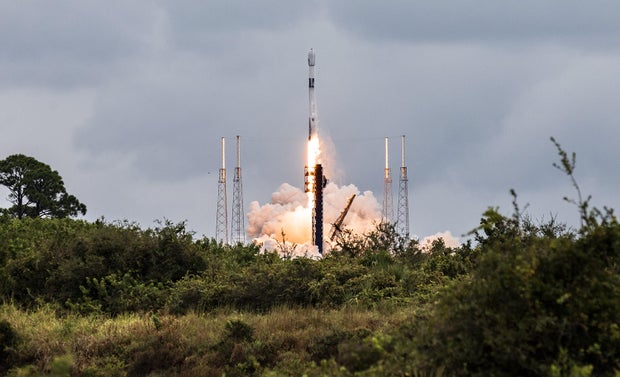
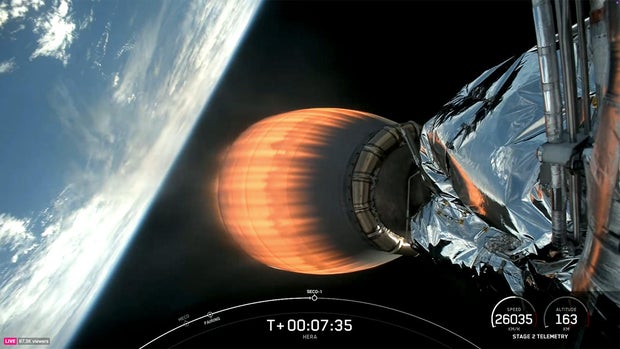
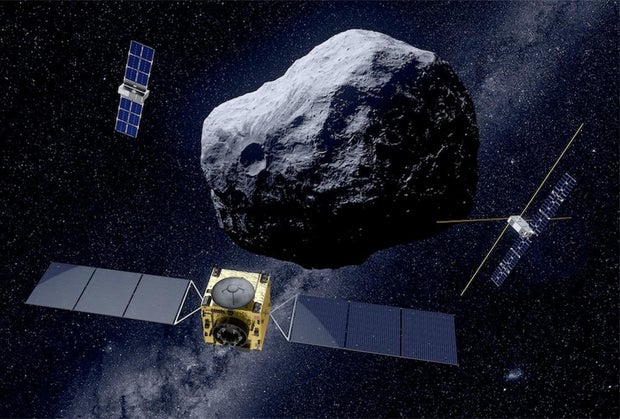
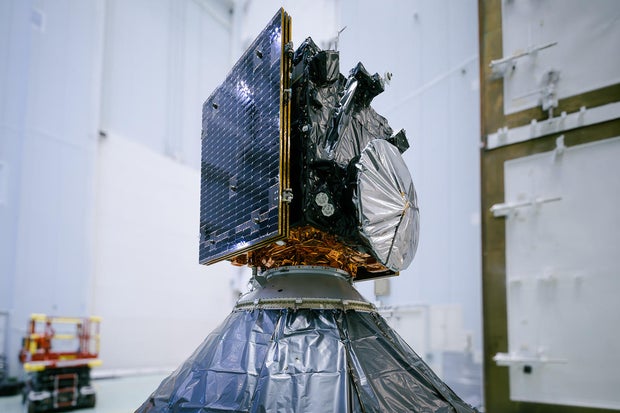

You must be logged in to post a comment Login